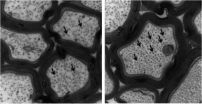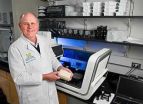(Press-News.org) WHAT:
Scientists supported by the National Institutes of Health (NIH) have determined the complete genetic blueprints for 13 different strains of Borrelia burgdorferi, the bacteria that cause Lyme disease. The achievement should lead to a better understanding of how genetic variations among strains may result in different courses of illness in people with Lyme disease, the most common tickborne disease in North America. The wealth of new genetic data will also help scientists develop improved ways to diagnose, treat and prevent Lyme disease.
The first genome of a strain of B. burgdorferi was sequenced more than 10 years ago. The 13 newly sequenced strains include ones isolated from humans and ticks and represent a range of geographic origins. Together, the genomes provide a more complete picture of scope of natural variations in the microbe and the disease it causes.
The sequencing and analysis was led by Claire M. Fraser-Liggett, Ph.D., of the University of Maryland School of Medicine, and was performed at a Microbial Sequencing Center funded by the NIH's National Institute of Allergy and Infectious Diseases (NIAID). The research project was initiated by Steven E. Schutzer, M.D., of the University of Medicine and Dentistry of New Jersey-New Jersey Medical School, an NIAID grantee.
Additional support was provided by the National Institute of General Medical Sciences and the National Center for Research Resources, both components of NIH.
ARTICLE:
SE Schutzer et al. Whole genome sequences of thirteen isolates of Borrelia burgdorferi. J. Bacteriology DOI: 10.1128/JB.01158-01 (2010).
WHO:
Joseph J. Breen, Ph.D., Bacteriology Program Officer, Division of Microbiology and Infectious Diseases, NIAID, is available to comment.
INFORMATION:
CONTACT:
To schedule interviews, please contact Anne A. Oplinger, 301-402-1663, aoplinger@niaid.nih.gov.
NIAID conducts and supports research—at NIH, throughout the United States, and worldwide—to study the causes of infectious and immune-mediated diseases, and to develop better means of preventing, diagnosing and treating these illnesses. News releases, fact sheets and other NIAID-related materials are available on the NIAID Web site at http://www.niaid.nih.gov.
The National Institutes of Health (NIH)—The Nation's Medical Research Agency—includes 27 Institutes and Centers and is a component of the U. S. Department of Health and Human Services. It is the primary federal agency for conducting and supporting basic, clinical and translational medical research, and it investigates the causes, treatments and cures for both common and rare diseases. For more information about NIH and its programs, visit http://www.nih.gov.
NIH-funded scientists sequence genomes of lyme disease bacteria
2010-10-19
ELSE PRESS RELEASES FROM THIS DATE:
Lastest graphene research could lead to improvements in bluetooth headsets and other devices
2010-10-19
RIVERSIDE, Calif. (www.ucr.edu) – Researchers at the UC Riverside Bourns College of Engineering have built and successfully tested an amplifier made from graphene that could lead to more efficient circuits in electronic chips, such as those used in Bluetooth headsets and toll collection devices in cars.
Graphene, a single-atom thick carbon crystal, was first isolated in 2004 by Andre Geim and Konstantin Novoselov, who won the Nobel Prize in physics this month for that work. Graphene has many extraordinary properties, including superior electrical and heat conductivity, ...
Optical technique reveals unnexpected complexity in mammalian olfactory coding
2010-10-19
Cold Spring Harbor, NY -- A team co-led by neuroscientists at Cold Spring Harbor Laboratory (CSHL) has shed light -- literally -- on circuitry underlying the olfactory system in mammals, giving us a new view of how that system may pull off some of its most amazing feats.
It has long been known from behavioral experiments that rodents, for instance, can tell the difference between two quite similar odors in a single sniff. But in such instances, what precisely happens in the "wiring" leading from sensory neurons in the nose to specialized cells in the olfactory bulb ...
Plastic monitors itself
2010-10-19
When the storm winds blow, wind turbines have to show what they can stand up to. The wind blows hard against mills with the force of tons as the tips of the blades plow through the air at more than 200 kilometers per hour. But natural forces not only tear at wind turbines; machine components made of plastic or airplane wings must with stand substantial loads as well.
These days, we normally use sensors to measure whether these components are strained beyond capacity, and it requires a lot of effort to install them into the component parts or glue them onto their surface. ...
Few nurse practitioners, physician assistants pursue careers in pediatric health
2010-10-19
ANN ARBOR, Mich. — Pediatric health care work force planning efforts are increasingly incorporating the roles of nurse practitioners and physician assistants, especially in plans to alleviate the perceived shortage of pediatric subspecialists.
However, results from four new studies of pediatric nurse practitioners, family nurse practitioners, neonatal nurse practitioners, and pediatric physician assistants published online today in the journal Pediatrics do not seem to support that idea. The work was conducted by the University of Michigan's Child Health Evaluation and ...
Penn study gives hope for new class of Alzheimer's disease drugs
2010-10-19
PHILADELPHIA – Finding a drug that can cross the blood-brain barrier is the bane of drug development for Alzheimer's disease and other neurological disorders of the brain. A new Penn study, published this week in the Journal of Neuroscience, has found and tested in an animal model of Alzheimer's disease a class of drug that is able to enter the brain, where it stabilizes degenerating neurons and improves memory and learning.
In the normal brain, the protein tau plays an important role in stabilizing structures called microtubules in nerve cells, which serve as tracks ...
ORNL theorist part of team that discovers unexpected magnetism
2010-10-19
OAK RIDGE, Tenn., Oct. 18, 2010 -- Theoretical work done at the Department of Energy's Oak Ridge National Laboratory has provided a key to understanding an unexpected magnetism between two dissimilar materials.
The results, published in Nature Communications, have special significance for the design of future electronic devices for computations and telecommunications, according to co-author Satoshi Okamoto of ORNL's Materials Science and Technology Division. The work was performed at Universidad Complutense de Madrid, synchrotron radiation facilities in France and Japan, ...
Four new psoriasis 'hotspots' identified by U-M geneticists
2010-10-19
ANN ARBOR, Mich. — Scientists at the University of Michigan Heath System and their collaborators have found four new DNA "hotspots" that may one day help guide new treatments for psoriasis, one of the most common autoimmune diseases in the country.
Using cutting-edge methods to peer into the hidden genetic underpinnings of the disabling and disfiguring disease, the research, published in Nature Genetics, further maps the as-yet unknown territories of psoriasis and psoriatic arthritis.
The findings could lead to new drug targets and tailored treatments for the skin ...
Japanese researchers report on liver transplantation studies using animal and iPS cells
2010-10-19
Tampa, Fla. (October 18, 2010) –Two research teams from the Okayama University Graduate School of Medicine (Okayama, Japan) have reported breakthrough studies in liver cell transplantation. One team found that the technical breakthrough in creating induced pluripotent stem cells (iPS) from mouse somatic cells (nonsex cells) in vitro had "implications for overcoming immunological rejection." Whereas a second team using liver cell xenotransplantation - transplanting cells of one species into another (in this case transplanting pig liver cells into mice) - found that transplanted ...
Vitamin D deficiency linked to lung transplant rejection
2010-10-19
MAYWOOD, Ill. -- Vitamin D deficiency is associated with a significant increase in lung transplant rejection, according to research conducted at Loyola University Health System (LUHS). These data were presented Monday at The American Society for Bone and Mineral Research 2010 annual meeting in Toronto, Ontario.
"Vitamin D deficiency is prevalent among lung transplant recipients," said Pauline Camacho, MD, study investigator and director of the Loyola University Osteoporosis and Metabolic Bone Disease Center. "This study shed greater light on the serious impact that this ...
Does clenching your muscles increase willpower?
2010-10-19
The next time you feel your willpower slipping as you pass that mouth-watering dessert case, tighten your muscles. A new study in the Journal of Consumer Research says firming muscles can shore up self-control.
Authors Iris W. Hung (National University of Singapore) and Aparna A. Labroo (University of Chicago) put study participants through a range of self-control dilemmas that involved accepting immediate pain for long-term gain. In one study, participants submerged their hands in an ice bucket to demonstrate pain resistance. In another, participants consumed a healthy ...


